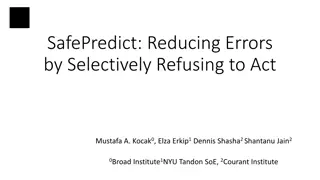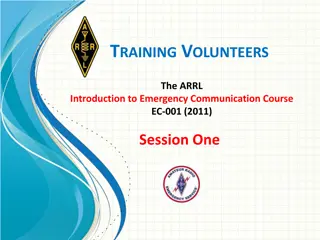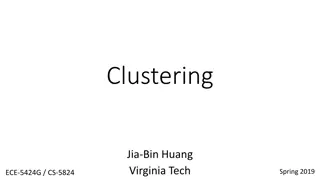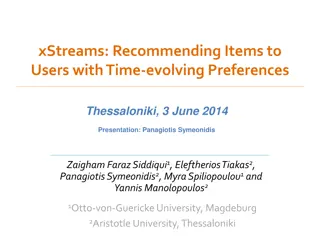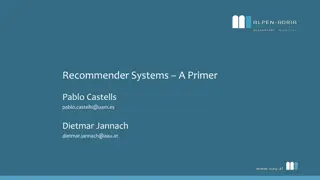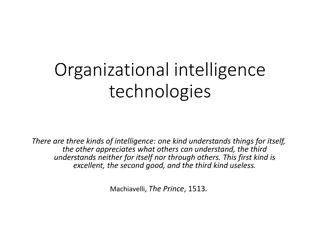Understanding Different Types of Recommender Systems
Recommender systems play a crucial role in providing personalized recommendations to users. This article delves into various types of recommender systems including Collaborative Filtering, Content-Based, Knowledge-Based, and Group Recommender Systems. Collaborative Filtering involves making predictions based on user preferences, while Content-Based systems recommend items similar to those liked by the user. Knowledge-Based systems leverage structured data for recommendations, and Group Recommender Systems focus on providing recommendations for a group of users. Explore the intricacies of each system to understand how they enhance user experience.
Download Presentation

Please find below an Image/Link to download the presentation.
The content on the website is provided AS IS for your information and personal use only. It may not be sold, licensed, or shared on other websites without obtaining consent from the author. Download presentation by click this link. If you encounter any issues during the download, it is possible that the publisher has removed the file from their server.
E N D
Presentation Transcript
RECOMMENDER SYSTEMS What is a recommender system? Recommender System Types Collaborative Filtering Content Based Group Knowledge Based Hybrid
COLLABORATIVE FILTERING Collaborative filtering has two senses, a narrow one and a more general one. In the newer, narrower sense, collaborative filtering is a method of making automatic predictions (filtering) about the interests of a user by collecting preferences or taste information from many users (collaborating). The underlying assumption of the collaborative filtering approach is that if a person A has the same opinion as a person B on an issue, A is more likely to have B's opinion on a different issue than that of a randomly chosen person. For example, a collaborative filtering recommendation system for television tastes could make predictions about which television show a user should like given a partial list of that user's tastes (likes or dislikes). Note that these predictions are specific to the user, but use information gleaned from many users. This differs from the simpler approach of giving an average (non- specific) score for each item of interest, for example based on its number of votes. In the more general sense, collaborative filtering is the process of filtering for information or patterns using techniques involving collaboration among multiple agents, viewpoints, data sources, etc. Applications of collaborative filtering typically involve very large data sets. Matrix Factorization
CONTENT-BASED RECOMMENDER SYSTEMS Content-based recommendation engine works with existing profiles of users. A profile has information about a user and their taste. Taste is based on user rating for different items. Generally, whenever a user creates his profile, recommendation engine does a user survey to get initial information about the user in order to avoid new user problem. In the recommendation process, the engine compares the items that are already positively rated by the user with the items he didn t rate and looks for similarities. Items similar to the positively rated ones will be recommended to the user. Here, based on user s taste and behavior a content-based model can be built by recommending articles relevant to user s taste. Such a model is efficient and personalized yet it lacks something.
KNOWLEDGE-BASED RECOMMENDER SYSTEMS The knowledge-based recommender system is similar to the content-based recommender system. However, it differs in that the information leveraged for remediation is derived from a structured source rather than an unstructured source. In other words, items are recommended within the context of explicit knowledge, item constraints/rules, consumer preferences, and/or recommendation criteria.
GROUP RECOMMENDER SYSTEMS Up to this point, item recommendations have been focused on one consumer, but item recommendations are also needed for a group of consumers. An aggregate metric or heuristic is calculated for the group for the recommendation basis. For example, the metric may be minimizing the suffering or maximizing the pleasure of a group. Real world examples of group recommender systems have application to family, urban, art, and venue planning
HYBRID RECOMMENDER SYSTEMS Most recommender systems now use a hybrid approach, combining collaborative filtering, content-based filtering, and other approaches. There is no reason why several different techniques of the same type could not be hybridized. Hybrid approaches can be implemented in several ways: by making content-based and collaborative-based predictions separately and then combining them; by adding content-based capabilities to a collaborative-based approach (and vice versa); or by unifying the approaches into one model. Several studies that empirically compare the performance of the hybrid with the pure collaborative and content-based methods and demonstrated that the hybrid methods can provide more accurate recommendations than pure approaches.





